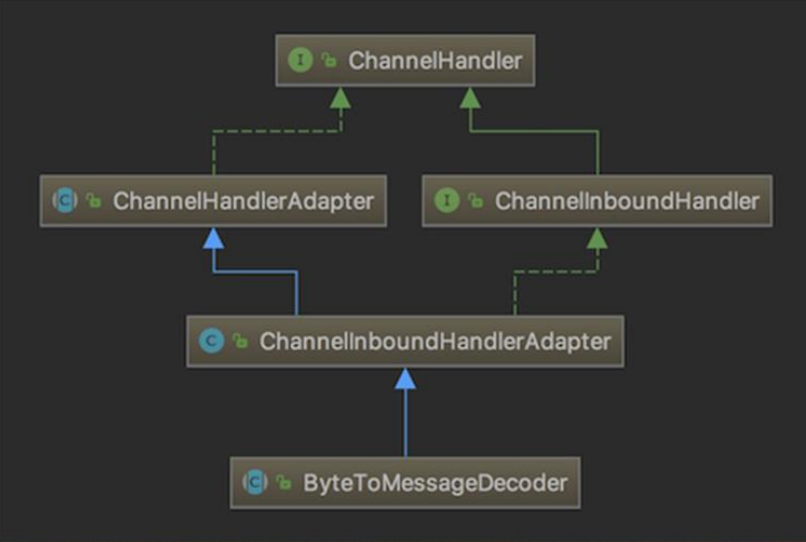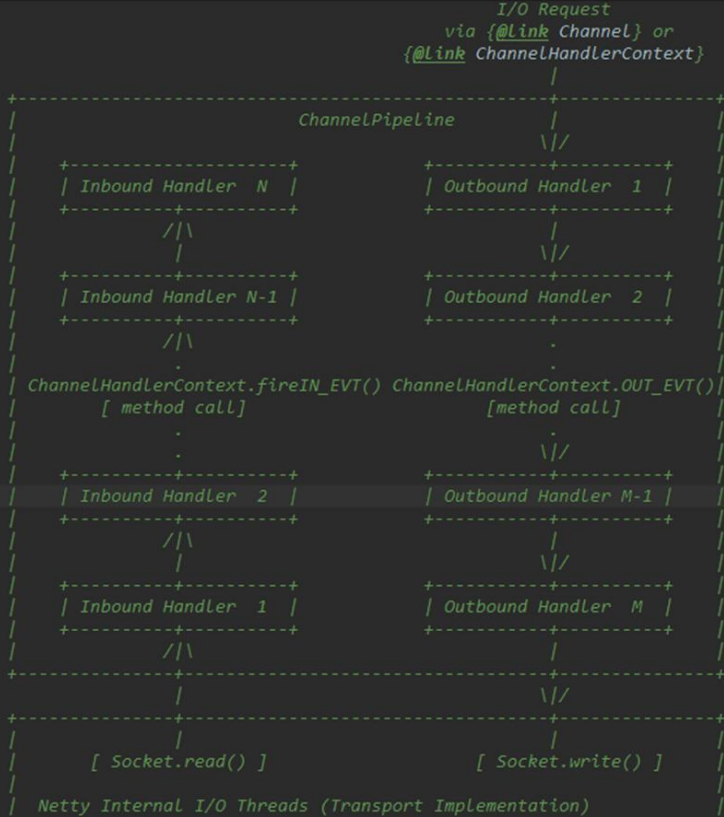基本说明
- Netty的组件设计: Netty的主要组件有Channel, EventLoop, ChannelFuture, ChannelHandler, ChannelPipeline等
- ChannelHandler充当了处理入站和出站数据的应用程序逻辑的容器, 例如: 实现ChannelInboundHandler接口(或ChannelInboundHandlerAdapter), 你就可以接收入站事件和数据, 这些数据会被业务逻辑处理, 当要给客户端发送响应时, 也可以从ChannelInboundhandler冲刷数据, 业务逻辑通常写在一个或多个ChannelInboundHandler中,ChannelOutboundHandler原理一样, 只不过她是用来处理出站数据的
- ChannelPipeline提供了ChannelHandler链的容器, 以客户端应用程序为例, 例如事件的运动方向是从客户端到服务端的,那么我们称这些事件为出站, 即客户端发送给服务端的数据会通过pipeline中的一系列ChannelOutboundHandler, 并被这些Handler处理, 反之则称为入站
编码解码器
- 当Netty发送或者接收一个消息的时候, 就将会发生一次数据转换, 入站消息会被解码, 从字节转换为另一种格式(比如Java对象) ;如果是出站消息, 他就会被编码成字节
Netty提供了一系列实用的编解码器, 他们都实现了ChannelInboundHandler或者ChannelOutboundHandler接口,在这些类中ChannelRead方法已经被重写, 以入站为例,对于每个从入站Channel读取的消息, 这个方法会被调用, 随后, 他将调用由解码器所提供的decoder()方法进行解码, 并将已经解码的字节转发给ChannelPipeline中的下一个ChannelInboundHandler
解码器 - ByteToMessageDecoder
关系继承图

- 由于不可能知道远程节点是否会一次性发送一个完整的消息, TCP有可能出现粘包拆包的问题, 这个类会对入站数据进行缓冲, 直到它准备好被处理
- 一个关于ByteToMessageDecoder实例分析
Netty的handler链调用机制
需求
- 使用自定义的编码器和解码器来说明Netty的handler调用机制
- 客户端发送long到服务器
- 服务器发送Long到客户端
- 案例演示
NettyServer
package com.dance.netty.netty.inandout;import io.netty.bootstrap.ServerBootstrap;import io.netty.channel.ChannelFuture;import io.netty.channel.ChannelInitializer;import io.netty.channel.ChannelOption;import io.netty.channel.ChannelPipeline;import io.netty.channel.nio.NioEventLoopGroup;import io.netty.channel.socket.SocketChannel;import io.netty.channel.socket.nio.NioServerSocketChannel;import io.netty.handler.logging.LogLevel;import io.netty.handler.logging.LoggingHandler;public class NettyServer {public static void main(String[] args) throws InterruptedException {NioEventLoopGroup bossGroup = new NioEventLoopGroup(1);NioEventLoopGroup workerGroup = new NioEventLoopGroup();try {ServerBootstrap serverBootstrap = new ServerBootstrap();serverBootstrap.group(bossGroup,workerGroup).channel(NioServerSocketChannel.class).option(ChannelOption.SO_BACKLOG, 128).childOption(ChannelOption.SO_KEEPALIVE, true).handler(new LoggingHandler(LogLevel.INFO)).childHandler(new ChannelInitializer<SocketChannel>() {@Overrideprotected void initChannel(SocketChannel ch) throws Exception {ChannelPipeline pipeline = ch.pipeline();// 添加自己的处理器// 入站的Handler进行解码 MyByteToLongDecoderpipeline.addLast("longDecoder", new MyByteToLongDecoder());// 对long类型进行编码的编码器pipeline.addLast("longEncoder", new MyLongToByteEncoder());// 处理入站数据pipeline.addLast(new NettyServerHandler());}});ChannelFuture sync = serverBootstrap.bind("127.0.0.1", 7000).sync();System.out.println("server is ready ......");sync.channel().closeFuture().sync();} catch (InterruptedException e) {e.printStackTrace();} finally {bossGroup.shutdownGracefully();workerGroup.shutdownGracefully();}}}
NettyServerHandler
package com.dance.netty.netty.inandout;import io.netty.channel.ChannelHandlerContext;import io.netty.channel.SimpleChannelInboundHandler;public class NettyServerHandler extends SimpleChannelInboundHandler<Long> {@Overrideprotected void channelRead0(ChannelHandlerContext ctx, Long msg) throws Exception {System.out.println("服务器收到来自客户端的消息 : " + msg.toString());// 回显客户端ctx.writeAndFlush(msg);}@Overridepublic void exceptionCaught(ChannelHandlerContext ctx, Throwable cause) throws Exception {ctx.close();cause.printStackTrace();}}
NettyClient
package com.dance.netty.netty.inandout;
import io.netty.bootstrap.Bootstrap;
import io.netty.channel.ChannelFuture;
import io.netty.channel.ChannelInitializer;
import io.netty.channel.ChannelPipeline;
import io.netty.channel.nio.NioEventLoopGroup;
import io.netty.channel.socket.SocketChannel;
import io.netty.channel.socket.nio.NioSocketChannel;
public class NettyClient {
public static void main(String[] args) throws InterruptedException {
NioEventLoopGroup eventExecutors = new NioEventLoopGroup();
try {
Bootstrap bootstrap = new Bootstrap();
bootstrap.group(eventExecutors)
.channel(NioSocketChannel.class)
.handler(new ChannelInitializer<SocketChannel>() {
@Override
protected void initChannel(SocketChannel ch) throws Exception {
ChannelPipeline pipeline = ch.pipeline();
// 解析Long类型的解析器
pipeline.addLast("longDecoder", new MyByteToLongDecoder());
// 对long类型进行编码的编码器
pipeline.addLast("longEncoder", new MyLongToByteEncoder());
// 自己的数据处理器
pipeline.addLast(new NettyClientHandler());
}
});
ChannelFuture sync = bootstrap.connect("127.0.0.1", 7000).sync();
sync.channel().closeFuture().sync();
} catch (InterruptedException e) {
e.printStackTrace();
} finally {
eventExecutors.shutdownGracefully();
}
}
}
NettyClientHandler
package com.dance.netty.netty.inandout;
import io.netty.buffer.Unpooled;
import io.netty.channel.ChannelHandlerContext;
import io.netty.channel.SimpleChannelInboundHandler;
import java.nio.charset.StandardCharsets;
public class NettyClientHandler extends SimpleChannelInboundHandler<Long> {
@Override
public void channelActive(ChannelHandlerContext ctx) throws Exception {
// 发送消息到服务器
// 正常数据
ctx.writeAndFlush(1234567890L);
/*
* 分析:
* 1. "qwerqwerqwerqwer" 是16个字节
* 2. 该处理器的前一个Handler是MyLongToByteEncoder
* 3. MyLongToByteEncoder 的父类是 MessageToByteEncoder
* 4. MessageToByteEncoder 类中 有一个模板方法, 里面调用了我们自己实现的encode方法, 因为是模板方法所以里面有逻辑(重要),分析一下
* @Override
public void write(ChannelHandlerContext ctx, Object msg, ChannelPromise promise) throws Exception {
ByteBuf buf = null;
try {
* // 重点: 判断 消息是否和当前的编码器匹配 如果匹配才往下走
if (acceptOutboundMessage(msg)) {
@SuppressWarnings("unchecked")
* // 转换消息类型为定义类型
I cast = (I) msg;
* // 构造成 ByteBuf
buf = allocateBuffer(ctx, cast, preferDirect);
try {
* // 重点: 调用我们自己实现的encode方法 传入case, 也就是我们发送的数据
encode(ctx, cast, buf);
} finally {
ReferenceCountUtil.release(cast);
}
if (buf.isReadable()) {
ctx.write(buf, promise);
} else {
buf.release();
ctx.write(Unpooled.EMPTY_BUFFER, promise);
}
buf = null;
} else {
* // 重点: 不匹配直接发送, 不走encode方法
ctx.write(msg, promise);
}
} catch (EncoderException e) {
throw e;
} catch (Throwable e) {
throw new EncoderException(e);
} finally {
if (buf != null) {
buf.release();
}
}
}
* 5. 因此我们在编写Encoder的时候, 要注意 传入的数据类型要和Encode的处理类型一致
*/
// 其他类型数据
// ctx.writeAndFlush(Unpooled.copiedBuffer("qwerqwerqwerqwer", StandardCharsets.UTF_8));
}
@Override
protected void channelRead0(ChannelHandlerContext ctx, Long msg) throws Exception {
System.out.println("客户端接收来自服务器的消息: " + msg.toString());
}
}
MyByteToLongDecoder
package com.dance.netty.netty.inandout;
import io.netty.buffer.ByteBuf;
import io.netty.channel.ChannelHandlerContext;
import io.netty.handler.codec.ByteToMessageDecoder;
import java.util.List;
/**
* 自定义解码器
*/
public class MyByteToLongDecoder extends ByteToMessageDecoder {
/**
* 解码方法 会根据接收到的数据被调用多次 直到确定没有新的元素被添加到 List中
* 或者ByteBuf没有更多的可读字节为止
* 如果List out 不为空 就会将list的内容传递给下一个ChannelInboundHandler进行处理 该方法也会被调用多次
* @param ctx 上下文对象
* @param in 入站的ByteBuf
* @param out 输出给下一个调用链的数据容器
* @throws Exception
*/
@Override
protected void decode(ChannelHandlerContext ctx, ByteBuf in, List<Object> out) throws Exception {
// 应为这个是一个Long的解码器, 所以只处理Long类型的数据
// 默认Long是8个字节
if(in.readableBytes() >= 8){
out.add(in.readLong());
}else{
// TODO 不够一个Long的数据, 不处理
}
}
}
MyLongToByteEncoder
package com.dance.netty.netty.inandout;
import io.netty.buffer.ByteBuf;
import io.netty.channel.ChannelHandlerContext;
import io.netty.handler.codec.ByteToMessageDecoder;
import io.netty.handler.codec.MessageToByteEncoder;
import java.util.List;
/**
* 自定义编码器
*/
public class MyLongToByteEncoder extends MessageToByteEncoder<Long> {
/**
* 编码方法
* @param ctx 上下文
* @param msg 消息
* @param out 输出给下一个编码器的ByteBuf
* @throws Exception 异常
*/
@Override
protected void encode(ChannelHandlerContext ctx, Long msg, ByteBuf out) throws Exception {
if(msg != null){
out.writeLong(msg);
}
}
}
- 测试 执行结果
Server
一月 18, 2022 12:05:45 上午 io.netty.handler.logging.LoggingHandler channelRegistered
信息: [id: 0x1a8323fa] REGISTERED
一月 18, 2022 12:05:45 上午 io.netty.handler.logging.LoggingHandler bind
信息: [id: 0x1a8323fa] BIND: /127.0.0.1:7000
一月 18, 2022 12:05:45 上午 io.netty.handler.logging.LoggingHandler channelActive
信息: [id: 0x1a8323fa, L:/127.0.0.1:7000] ACTIVE
server is ready ......
一月 18, 2022 12:05:50 上午 io.netty.handler.logging.LoggingHandler channelRead
信息: [id: 0x1a8323fa, L:/127.0.0.1:7000] READ: [id: 0xac268da1, L:/127.0.0.1:7000 - R:/127.0.0.1:55730]
一月 18, 2022 12:05:50 上午 io.netty.handler.logging.LoggingHandler channelReadComplete
信息: [id: 0x1a8323fa, L:/127.0.0.1:7000] READ COMPLETE
服务器收到来自客户端的消息 : 1234567890
Client
客户端接收来自服务器的消息: 1234567890
- 调用图


结论
public abstract class ReplayingDecoder
extends ByteToMessgaeDecoderReplayingDecoder 扩展了 ByteToMessageDecoder类, 使用这个类 我们不必调用readableBytes()方法 参数 S 指定了用户状态管理的类型, 其中Void代表不需要状态管理应用实例: 使用ReplayingDecoder编写解码器, 对前面的案例进行简化[案例演示] ```java package com.dance.netty.netty.inandout;
import io.netty.buffer.ByteBuf; import io.netty.channel.ChannelHandlerContext; import io.netty.handler.codec.ByteToMessageDecoder; import io.netty.handler.codec.ReplayingDecoder;
import java.util.List;
/**
自定义解码器 */ public class MyByteToLongDecoder2 extends ReplayingDecoder
{ @Override protected void decode(ChannelHandlerContext ctx, ByteBuf in, List




